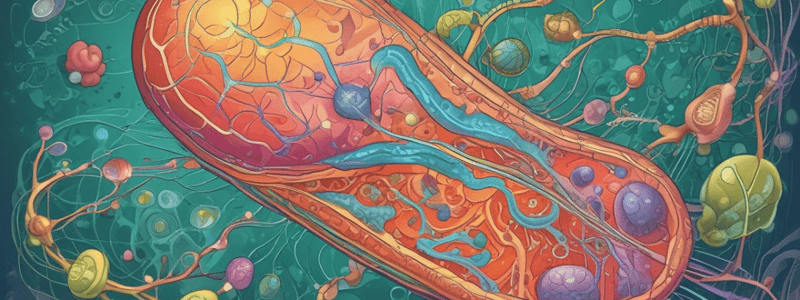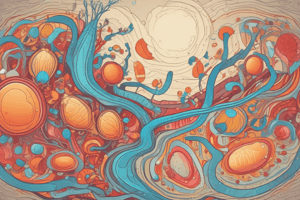Podcast
Questions and Answers
How many molecules of ATP does the average adult human synthesize per second?
How many molecules of ATP does the average adult human synthesize per second?
- 10^20
- 10^19
- 10^18
- 10^21 (correct)
What is the primary location of electron transport proteins in eukaryotic cells?
What is the primary location of electron transport proteins in eukaryotic cells?
- Cytosol
- Outer mitochondrial membrane
- Endoplasmic reticulum
- Inner mitochondrial membrane (correct)
What is the final step of the electron transport chain?
What is the final step of the electron transport chain?
- Reduction of O2 to water (correct)
- Reduction of NAD+ to NADH
- Synthesis of ATP from ADP
- Reduction of FAD to FADH2
How many moles of ATP are synthesized from the energy generated by the reoxidation of 1 mole of NADH?
How many moles of ATP are synthesized from the energy generated by the reoxidation of 1 mole of NADH?
How many dehydrogenation steps occur in the citric acid cycle?
How many dehydrogenation steps occur in the citric acid cycle?
What is the term for the process by which ATP is synthesized from the energy generated by the reoxidation of NADH and FADH2?
What is the term for the process by which ATP is synthesized from the energy generated by the reoxidation of NADH and FADH2?
What is the total number of moles of NAD+ reduced to NADH and FAD reduced to FADH2 per mole of glucose?
What is the total number of moles of NAD+ reduced to NADH and FAD reduced to FADH2 per mole of glucose?
What is the approximate weight of ATP synthesized by the average adult human per day?
What is the approximate weight of ATP synthesized by the average adult human per day?
Where are the enzyme complexes that reoxidize reduced electron carriers located?
Where are the enzyme complexes that reoxidize reduced electron carriers located?
What is the energy gradient created by the proton pumping action of the enzyme complexes used for?
What is the energy gradient created by the proton pumping action of the enzyme complexes used for?
What is the electron carrier that receives electrons from the oxidation of NADH and succinate?
What is the electron carrier that receives electrons from the oxidation of NADH and succinate?
What is the final electron acceptor in the respiratory chain?
What is the final electron acceptor in the respiratory chain?
What is the direction of proton pumping by the enzyme complexes?
What is the direction of proton pumping by the enzyme complexes?
What is the role of complex III in the respiratory chain?
What is the role of complex III in the respiratory chain?
What is the process by which protons re-enter the mitochondrial matrix?
What is the process by which protons re-enter the mitochondrial matrix?
What is the energy source that drives ATP synthesis?
What is the energy source that drives ATP synthesis?
What is the direction of the subunit rotation driven by the passage of protons through channels in F0?
What is the direction of the subunit rotation driven by the passage of protons through channels in F0?
What conformational change occurs in the T site after a 120° rotation of the subunit?
What conformational change occurs in the T site after a 120° rotation of the subunit?
What is the role of the nickel-coated bead in the experimental system?
What is the role of the nickel-coated bead in the experimental system?
What is the purpose of using streptavidin in the experimental system?
What is the purpose of using streptavidin in the experimental system?
What is observed during fluorescent microscopic examination after the addition of ATP and its subsequent hydrolysis?
What is observed during fluorescent microscopic examination after the addition of ATP and its subsequent hydrolysis?
What is the basis of the model of proton-driven rotation of the c-ring of the ATP synthase component?
What is the basis of the model of proton-driven rotation of the c-ring of the ATP synthase component?
What is the result of the conformational change in the L site after a 120° rotation of the subunit?
What is the result of the conformational change in the L site after a 120° rotation of the subunit?
What is the result of the conformational change in the O site after a 120° rotation of the subunit?
What is the result of the conformational change in the O site after a 120° rotation of the subunit?
What is the approximate number of moles of ATP synthesized from the complete oxidation of 1 mole of glucose?
What is the approximate number of moles of ATP synthesized from the complete oxidation of 1 mole of glucose?
What type of enzymes catalyze the oxidation of a substrate without incorporation of oxygen atoms into the product?
What type of enzymes catalyze the oxidation of a substrate without incorporation of oxygen atoms into the product?
What is the term for enzymes that incorporate oxygen atoms from O2 into the oxidized products?
What is the term for enzymes that incorporate oxygen atoms from O2 into the oxidized products?
What is the term for the class of enzymes that incorporate one atom from O2 into a product and reduce the other atom to water?
What is the term for the class of enzymes that incorporate one atom from O2 into a product and reduce the other atom to water?
Which of the following is an example of a dioxygenase enzyme?
Which of the following is an example of a dioxygenase enzyme?
What is the term for the enzyme complex that catalyzes the first reaction in tryptophan catabolism?
What is the term for the enzyme complex that catalyzes the first reaction in tryptophan catabolism?
What is the cofactor used by D-Amino acid oxidases?
What is the cofactor used by D-Amino acid oxidases?
What is the general term for enzymes that catalyze the oxidation of a substrate with the incorporation of oxygen atoms into the product?
What is the general term for enzymes that catalyze the oxidation of a substrate with the incorporation of oxygen atoms into the product?
What is the effect of adding an exogenous oxidizable substrate, such as glutamate, to carefully prepared coupled mitochondria?
What is the effect of adding an exogenous oxidizable substrate, such as glutamate, to carefully prepared coupled mitochondria?
Why is oxygen uptake recorded in moles O, rather than moles O2?
Why is oxygen uptake recorded in moles O, rather than moles O2?
What is the typical ratio of ATP to ADP in most aerobic cells?
What is the typical ratio of ATP to ADP in most aerobic cells?
What happens to respiration when ADP is depleted in a relaxed and well-nourished cell?
What happens to respiration when ADP is depleted in a relaxed and well-nourished cell?
What is the role of ADP in respiratory control?
What is the role of ADP in respiratory control?
What is the effect of adding ADP + Pi to carefully prepared coupled mitochondria?
What is the effect of adding ADP + Pi to carefully prepared coupled mitochondria?
What is the purpose of using oligomycins in this context?
What is the purpose of using oligomycins in this context?
Why does oxygen uptake slow down after the initial stimulation by ADP + Pi?
Why does oxygen uptake slow down after the initial stimulation by ADP + Pi?
Flashcards are hidden until you start studying
Study Notes
Electron Transport, Oxidative Phosphorylation, and Oxygen Metabolism
- The average adult human synthesizes ATP at a rate of nearly 10^21 molecules per second, equivalent to producing their own weight in ATP every day.
- Under aerobic conditions, six dehydrogenation steps (one in glycolysis, one in pyruvate dehydrogenase, and four in the citric acid cycle) collectively reduce 10 moles of NAD+ to NADH and 2 moles of FAD to FADH2 per mole of glucose.
- Reoxidation of these reduced electron carriers in the process of cellular respiration generates most of the energy needed for ATP synthesis.
- Oxidation of 1 mole of NADH by the respiratory chain provides sufficient energy for the synthesis of ~2.5 moles of ATP from ADP.
The Mitochondrion: Scene of the Action
- In eukaryotic cells, NADH and FADH2 are reoxidized by electron transport proteins bound to the inner mitochondrial membrane.
- A series of linked oxidation and reduction reactions occurs, with electrons being passed along a series of electron carriers—the electron transport chain.
- The final step is the reduction of O2 to water.
- The overall electron transport sequence is quite exergonic.
- One pair of reducing equivalents, generated from 1 mole of NADH, suffices to drive the synthesis of between 2 and 3 moles of ATP from ADP and Pi by a process termed oxidative phosphorylation.
Electron Transport
- Embedded within the inner mitochondrial membrane are the protein carriers that constitute the respiratory chain.
- Complex I and complex II receive electrons from the oxidation of NADH and succinate, respectively, and pass them along to a lipid-soluble electron carrier, coenzyme Q, which moves freely in the membrane.
- Complex III catalyzes the transfer of electrons from the reduced form of coenzyme Q to cytochrome c, a protein electron carrier that is also mobile within the intermembrane space.
- Complex IV catalyzes the oxidation of cytochrome c, reducing O2 to water.
- The energy released by these exergonic reactions creates a proton gradient across the inner membrane, with protons being pumped from the matrix into the intermembrane space.
- Protons then re-enter the matrix through a specific channel in complex V, driving the endergonic synthesis of ATP from ADP and inorganic phosphate.
Oxidative Phosphorylation
- The experimental system that permits observation of rotation in the F1 component of F1F0 ATP synthase involves immobilizing the complex on a nickel-coated bead and attaching it to a glass coverslip.
- Fluorescence microscopic examination showed that, following the addition of ATP and its subsequent hydrolysis by the catalytic subunits, the actin molecule was rotating, which proved that the subunit itself was rotating.
- Proton-driven rotation of the c-ring of the F1F0 ATP synthase has been demonstrated experimentally.
Respiratory Control
- In most aerobic cells, the level of ATP exceeds that of ADP by 4- to 10-fold.
- Respiratory control is a dependence of respiration on ADP as a substrate for phosphorylation.
- If the energy demands on a cell cause ATP to be consumed at high rates, the resultant accumulation of ADP will stimulate respiration, with concomitant activation of ATP resynthesis.
- Conversely, in a relaxed and well-nourished cell, ATP accumulates at the expense of ADP, and the depletion of ADP limits the rate of both electron transport and its own phosphorylation to ATP.
Oxygen as a Substrate for Other Metabolic Reactions
- The term oxidase is applied to enzymes that catalyze the oxidation of a substrate without incorporation of oxygen atom into the product.
- A two-electron oxidation is usually involved, so the oxygen is converted to H2O2.
- Most oxidases utilize either a metal or a flavin coenzyme.
- Oxygenases are enzymes that incorporate oxygen atoms from O2 into the oxidized products; there are two classes—monooxygenases and dioxygenases.
- Monooxygenases, which incorporate one atom from O2 into a product and reduce the other atom to water, are widely distributed and are also called mixed-function oxidases.
Studying That Suits You
Use AI to generate personalized quizzes and flashcards to suit your learning preferences.




